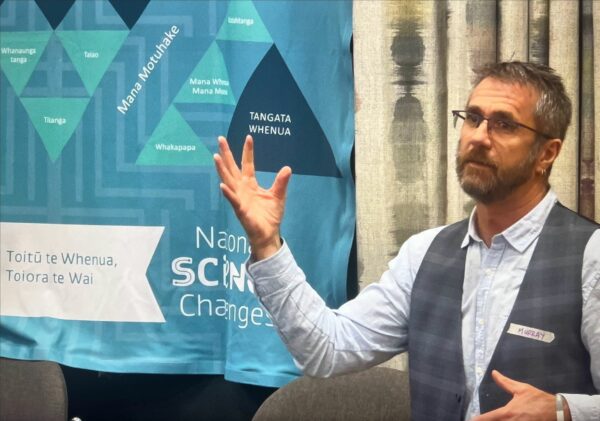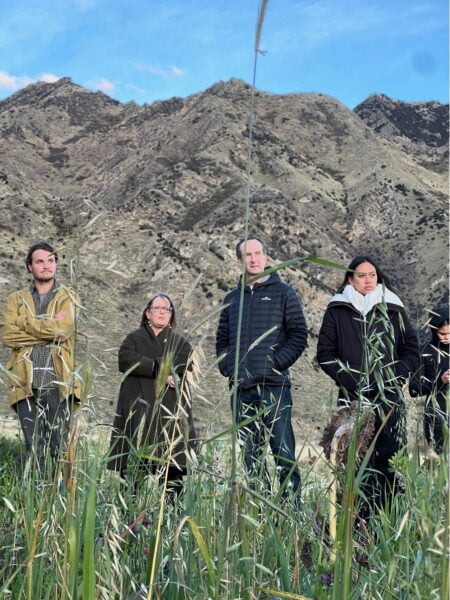Reflections at the Mid-Point of Revitalise te Taiao
The Revitalise Te Taiao programme gathered its people from across Ngā Kaiurungi Taiao – the three place-based pilots – on the shores of Lake Wānaka this winter to reflect, review, and focus on future plans for putting research into action.
The weaving together of mātauranga Māori and modern science to help revitalise Te Taiao is a powerful force. Each strand of knowledge needs to be carefully threaded to ensure that connection to te Taiao, people, and community remains at the heart of Revitalise Te Taiao, a research programme launched back in March 2022.
“Revitalise Te Taiao is a program of many moving parts,” says Helen Percy, Toitū te Whenua Toiora te Wai (Our Land and Water) science theme leader. “In some ways, it's new, it's experimental, and it's a way of doing research that is not conventional because it comes from the people from the groups. You are doing it as you go. It’s not a case study you look in on and research about. What is clearly seen and felt within this research project is the underlying values, wisdom, and integrity.”
As the snow-capped mountain ranges over Wānaka welcomed in the winter season, Ngā Kaiurungi Taiao – the three place-based pilots Knowledge into Action for Te Taiao from Wānaka, Rere ki Uta, Rere ki Tai from Paeroa, and Te Kahui Rau from Taranaki – congregated on the shores of Lake Wānaka. It was a time for the Revitalise Te Taiao whānau to regroup, reflect, review, and focus on plans moving forward.

One of the special guest speakers was Murray Hemi, mātauranga Māori expert, scientist, and founding working group member of Revitalise te Taiao. In his opening address, Murray took everyone back to the Taiao Manawa Ora purpose-led change framework; the very foundation of Revitalise te Taiao where the principles of Te Tiriti o Waitangi partnership, participation, and protection are central to how the implementation of work for te Taiao would take place.
He said it was amazing to see the concepts, the thoughts, the modeling created two years ago come into reality to be embodied in very practical, very pragmatic, very powerful ways. Murray explained the common threads in terms of the ideas that need to come from a central kaupapa, based on being in service to something that is greater and bigger than self. In most cases that is a connection to people, service, and te Taiao.

Revitalise te Taiao co-lead Dr James Turner says, “We’ve got a tight deadline of March 2024 to show the power of the way we are working around Taiao Manawa Ora and being able to share those stories and the evidence to demonstrate what can be achieved when you start with te Taiao and collectively work together, sharing our knowledge to support each other, weaving together knowledge in a way that upholds the mana and integrity of Revitalise te Taiao and all those engaged within this research kaupapa.”
While this has been a priority, it has required ongoing training and support around cultural competency in terms of Te Tiriti o Waitangi, te reo Māori, and tikanga Māori.
Trying to get the balance right to ensure that there is a collective voice from tangata whenua and tangata tiriti in terms of the knowledge systems of mātauranga Māori and modern science being explored within Ngā Kaiurungi Taiao will help assist the research outcomes.

The co-implementation lead Simon Stokes acknowledged the growth within Ngā Kaiurungi Taiao (the three place-based pilots) while also highlighting the challenges they each had to confront. “Everyone has had to deconstruct or decolonize and rebuild in a way that is true to self and true to the individual kaupapa that Ngā Kaiurungi Taiao brings that is deep, meaningful, and authentic. There is a sense of not just the challenges but also the right thinking around opportunities to progress relationships with mana whenua that benefit te Taiao.”
“For the Knowledge into Action for Te Taiao pilot, learning about the principles of Te Tiriti o Waitangi and trying to understand the history associated with mana whenua and the unique Taiao of Wānaka is an ongoing journey. The reality remains that in order to have genuine meaningful engagement with mana whenua of Wānaka it's going to take time well beyond this project,” he says.
The research program ends in March of 2024. Murray Hemi, co-creator of the Taiao Manawa Ora framework, believes the challenge for this whole project moving forward once it is completed is how the experience and the knowledge, framework, and philosophy do not get lost. Right now there is still lots of mahi to do. Murray shared his closing reflections on Ngā Kaiurungi Taiao.
“Te Kahui Rau has an intergenerational vision. It is such a powerful and massive horizon they are anticipating which is inevitable. Still, I think it is just really being grateful and noticing and recognizing the time when the step is ready to be realized knowing that there are many other steps that are also subsequent to follow.
“Rere ki Uta, Rere ki Tai is far-reaching and broad-minded. It's also focused and practical with a clear connection as to why it is doing things both in terms of the immediate returns and also how it connects to the big long-term picture.
“Knowledge into Action for Te Taiao are just kind of all guns blazing full steam ahead so there are a lot of things they are doing and a lot of things they are creating. There are some key pivotal elements, in particular the kind of relationships and connection and foundation with tangata whenua, and in this case Kai Tahu, that really need the space and time and the attention to be cared for, held and nurtured in order to really complete this project.”
Author
 View Our Strategy Document 2019 – 2024
View Our Strategy Document 2019 – 2024




Leave a Reply